

WEEK 47: NOVEMBER 15-21
TOPIC: COMETS AND METEOR SHOWERS
I first began to show an interest in astronomy when I was 6 years old, although my interests shifted between astronomy and various other scientific fields over the next few years. My father was an early riser, and one morning when I was 8 he was engaged in his normal morning routine when he noticed that an intense meteor shower was going on outside, and he came and aroused his astronomically-inclined son out of bed. Through our living room window we watched the meteors appearing so quickly it almost looked like it was snowing outside.
The date was November 17, 1966. What my father and I had witnessed was the Great Leonid Storm of 1966, one of the strongest meteor showers in all of recorded history. New Mexico, where we lived, and in fact the entire western part of the U.S., was in the right location to witness this event, and the peak rate, which lasted for perhaps twenty minutes, was somewhere between 100,000 and 150,000 meteors per hour.

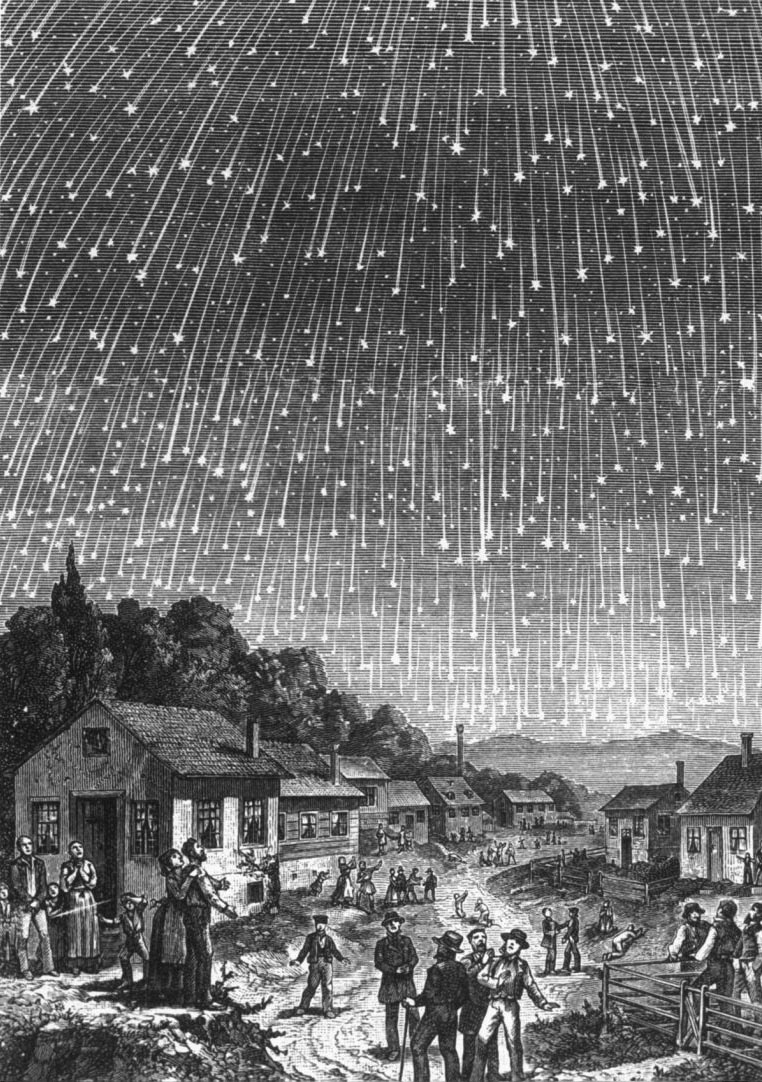
While the Leonid meteor shower is normally a pretty weak affair, producing no more than about ten meteors per hour, it has on occasion, like in 1966, produced significantly stronger displays. One such “storm” took place on October 13, 902, when observers in Europe, Egypt, and elsewhere reported that stars were falling “as thickly as snowflakes.” (The difference in calendar dates is due largely in part to the switch from the
It so happened that in mid-December 1865 the French astronomer Wilhelm Tempel had discovered a 6th-magnitude comet near the “bowl” of the Little Dipper, which in turn was independently discovered by the American astronomer Horace Tuttle in early January 1866 when it was near its peak brightness of magnitude 5.5. The following year the Austrian astronomer Theodor von Oppolzer calculated that that comet – now known as Comet 55P/Tempel-Tuttle – has an orbital period close to 33 years. It was obvious that the correspondence in orbital periods was not a coincidence, and the Italian astronomer Giovanni Schiaparelli soon conclusively demonstrated the relationship between that comet and the Leonid meteors.
Schiaparelli had also just recently demonstrated the relationship between another comet and a meteor shower: the comet now known as Comet 109P/Swift-Tuttle, which had been seen in 1862 (and which returned in 1992, and is a future “Comet of the Week”), and the Perseid meteor shower, which is one of the strongest of the “annual” meteor showers and which peaks during the second week of August each year. Over the years and decades which have elapsed since then, numerous other meteor showers have been found to be associated with various comets.
The strengths of the various meteor showers very widely, and can be affected by factors such as the activity level of the parent comet and the closest distance between the
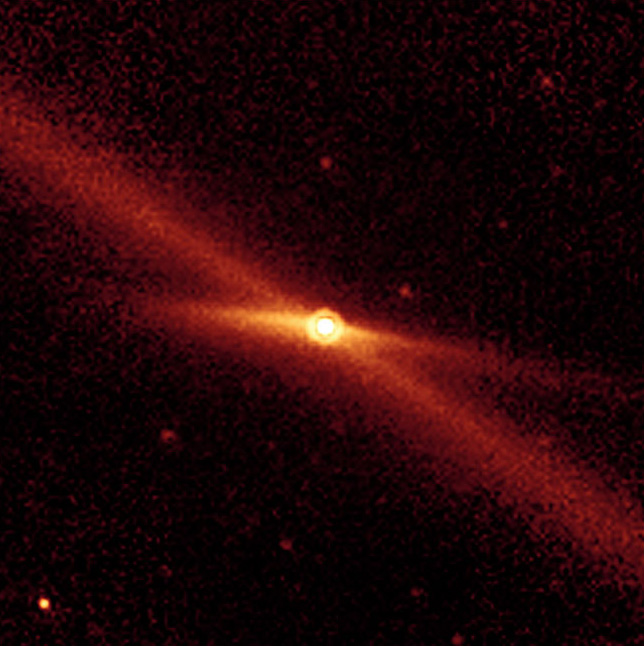
For some comets, 55P/Tempel-Tuttle being among them, the dust has not had enough time to spread out all along their respective orbits, and thus much of the dust travels in “clumps” close to the comet itself. The result of this is what we see with the Leonid shower: normally quite weak, but extremely intense around times that the comet returns to perihelion. Even here, the gravitational effects on the dust stream can affect the displays we see: while the Leonid shower associated with the comet’s return in 1866 was a strong one, the ones associated with the return in 1899 were much weaker, and only a slight enhancement of meteor activity was exhibited during the comet’s 1932 return. (For what it’s worth, the comet itself was missed during those returns). The situation was reversed for the 1965 return – when the comet was seen again, although it remained distant and faint – and the result was the extremely intense “storm” I witnessed the following year.
There was much anticipation among astronomers as Comet Tempel-Tuttle returned to perihelion again in 1998. It was duly recovered, and the viewing geometry was relatively favorable, with its reaching a peak brightness close to 8th magnitude early that year. Predictions seemed to suggest a strong Leonid display that year – and there indeed was one, although not as strong as originally expected, and in a departure from previous Leonid displays, this one lasted for the better part of a day and was widely viewed from around the world. (It also featured a large number of bright fireballs, and I personally consider it to be the second-best meteor shower I have ever seen, second only to the 1966 “storm.”)
Astronomers began to realize that, in order to make accurate predictions of a meteor shower’s display, it was necessary to take into account the dust streams released during individual returns of the parent comet. Two individuals who took this up were Rob McNaught in Australia and David Asher in Ireland, and together they predicted that a strong but brief display of the Leonids would be visible in 1999 from Europe and the Middle East. They turned out to be correct – with peak rates of between 3000 and 5000 meteors per hour being seen – and one interesting feature of this shower is that some observers recorded at least five bright flashes on the moon’s unlit portion that were apparently due to Leonid meteors striking the lunar surface. Meanwhile, and somewhat surprisingly, Asher and McNaught predicted that the strongest Leonid showers would take place in 2001 and 2002 – and, again, they were correct, although the 2002 shower coincided with full moon and from an observational perspective was not as impressive as it otherwise might have been.
The strongest of the “annual” showers are the Quadrantids in early January, the Perseids in August, and the Geminids in December, all of which can exhibit peak rates in excess of 100 meteors per hour (although the peak of the Quadrantid shower is very brief). While what one might consider a “strong” shower is perhaps somewhat subjective, the below table lists some of the stronger and more notable meteor showers that appear during the course of a typical year (keeping in mind that at least a few will be affected by strong moonlight). The table also gives the parent comet and the “zenithal hourly rate,” or ZHR, which is the peak rate that an observer would see with a perfectly clear and unobstructed sky from a dark rural site; the true observed rate will almost always be somewhat less than this.
| SHOWER | MAXIMUM DISPLAY (2020) | PARENT COMET | ZHR |
|---|---|---|---|
| Quadrantids | January 4 | (196256) 2003 EH1 | 120 |
| Lyrids | April 22 | Thatcher 1861 I | 18 |
| Eta Aquarids | May 5 | 1P/Halley | 50 |
| Arietids | June 7 | SOHO P/1999 J6? | 30 |
| Delta Aquarids | July 30 | 96P/Machholz 1? | 16 |
| Perseids | August 12 | 109P/Swift-Tuttle | 110 |
| Draconids | October 8 | 21P/Giacobini-Zinner | 10 |
| Orionids | October 21 | 1P/Halley | 20 |
| Taurids | November 12 | 2P/Encke | 5 |
| Leonids | November 17 | 55P/Tempel-Tuttle | 10 |
| Andromedids | December 2 | 3D/Biela | 3 |
| Geminids | December 14 | (3200) Phaethon | 150 |
| Ursids | December 22 | 8P/Tuttle | 10 |
The Draconids and Andromedids are “clumpy” showers like the Leonids that have produced intense displays in the past, and are discussed more thoroughly in the “Comet of the Week” presentations for their respective parent comets. While at face value it may not appear to be one of the stronger meteor showers, the Lyrids have on rare occasions produced strong displays (700 per hour in 1803 and 90 per hour in 1922 and 1982); the parent comet, incidentally, has an approximate orbital period of 415 years. The Ursids have also occasionally produced some strong displays, sometimes when the parent comet is near aphelion. The Arietids are the strongest of the daytime meteor showers, observable via radar techniques (described in a previous “Special Topics” presentation), although a few meteors may be visible during dawn. The likely parents are the Marsden “family” of near-sun comets discussed in the upcoming “Special Topics” presentation on comet and asteroid “families.”
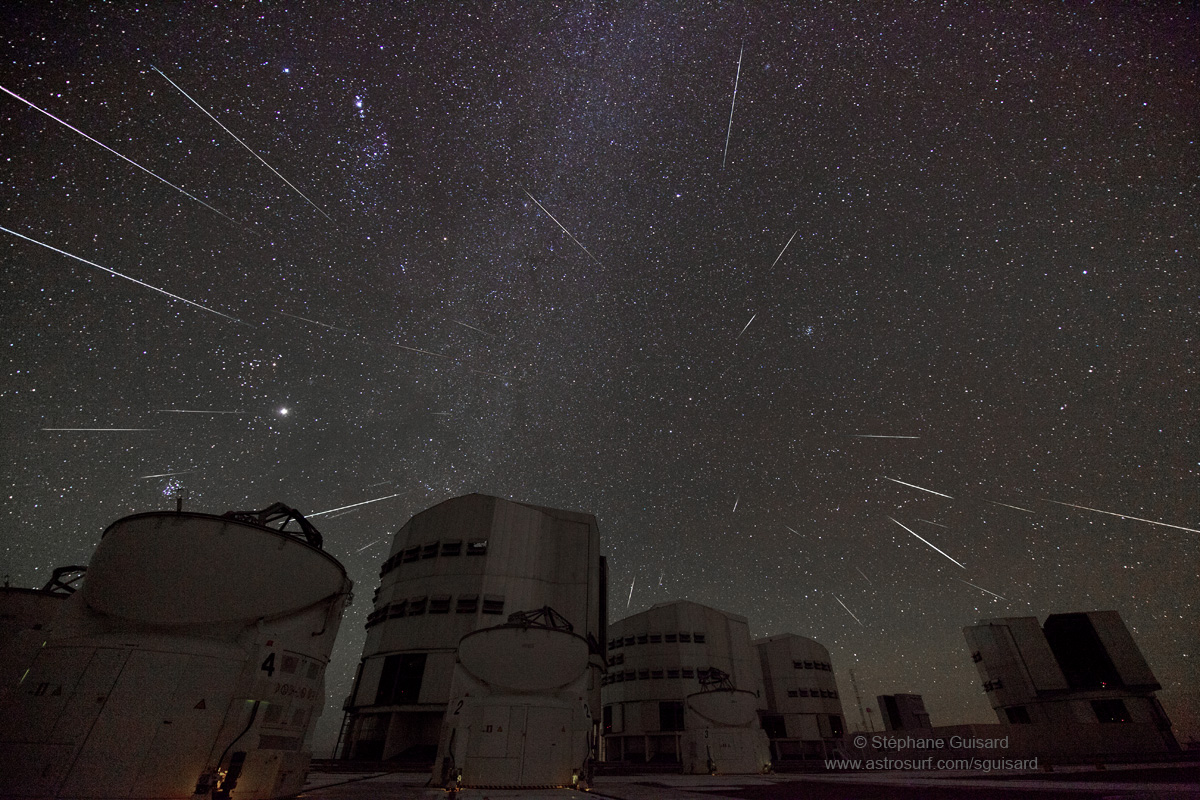
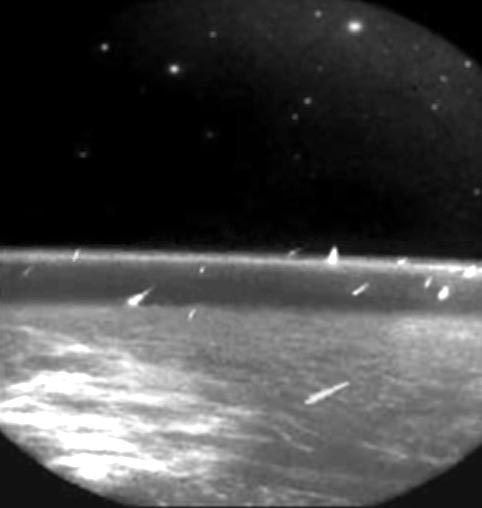 LEFT: A composite of 30 images of the Geminid meteor shower over the European Southern Observatory in Chile. Photo copyright Stephane Guisard (Instagram), used with permission. RIGHT: The 1997 Leonid meteor shower from space. This is a composite image taken (over a span of 48 minutes) by the Midcourse Space Experiment (MSX) satellite on November 17, 1997. Courtesy Peter Jenniskens and colleagues, Applied Physics Laboratory, USIVI, MSX, and BMDO.
LEFT: A composite of 30 images of the Geminid meteor shower over the European Southern Observatory in Chile. Photo copyright Stephane Guisard (Instagram), used with permission. RIGHT: The 1997 Leonid meteor shower from space. This is a composite image taken (over a span of 48 minutes) by the Midcourse Space Experiment (MSX) satellite on November 17, 1997. Courtesy Peter Jenniskens and colleagues, Applied Physics Laboratory, USIVI, MSX, and BMDO.
It will be noticed, of course, that the parent “comets” of two of the strongest meteor showers are apparent asteroids, and this hearkens back somewhat to the active-comet-to-inert-asteroid discussion in an earlier “Special Topics” presentation. (3200) Phaethon was discovered by the InfraRed Astronomical Satellite (IRAS) spacecraft in 1983 and has an orbital period as small as 1.4 years and a very small perihelion distance of 0.14 AU; it has been observed to exhibit “cometary” activity of sorts when near perihelion and is discussed more thoroughly in an upcoming “Special Topics” presentation on “Active Asteroids.” (196256) 2003 EH1, which was discovered in 2003 by the LONEOS program in Arizona, has an orbital period of 5.5 years and a perihelion distance of 1.19 AU; it has never been seen to exhibit any kind of cometary activity, but on the other hand it has never been observed close to Earth and thus far hasn’t been amenable to any detailed investigations. (Indeed, its next “close” approach to Earth doesn’t take place until 2052, and that is still a somewhat distant 0.33 AU.)
On any given night, even if it is not around the time of the “major” showers, at least a few of the minor showers are active, and almost all of the meteors that appear --
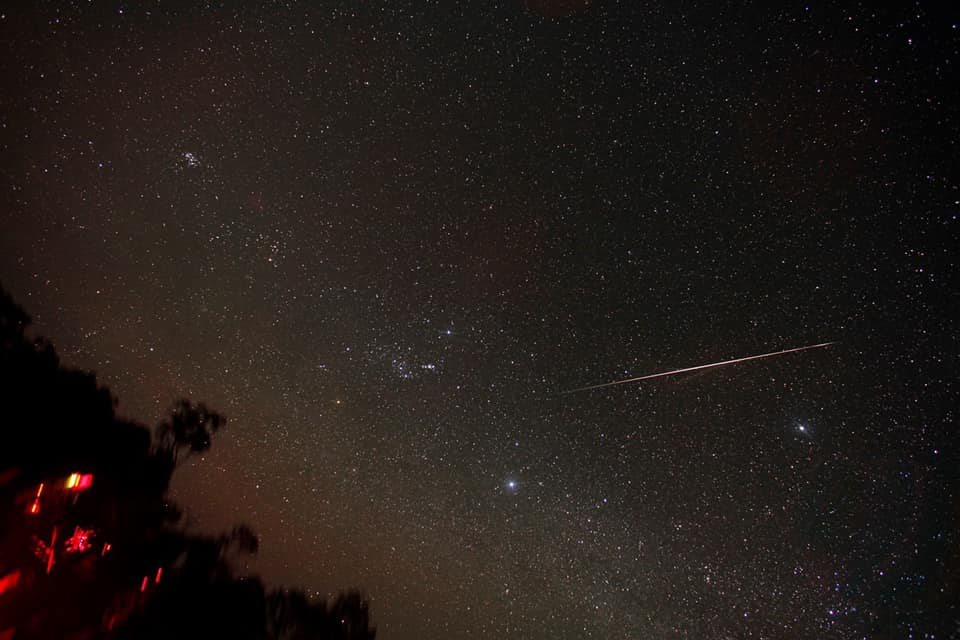
even the “sporadic” ones -- are members of some shower or other. Just about any meteor we might see, then, has come to us from the nucleus of some comet at some point in time in the past.
“Special Topics” archive
Ice and Stone 2020 home page
Earthrise Institute home page